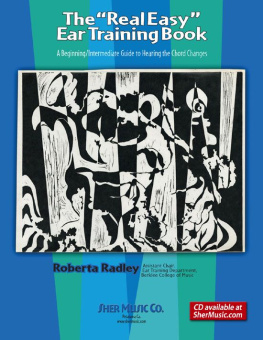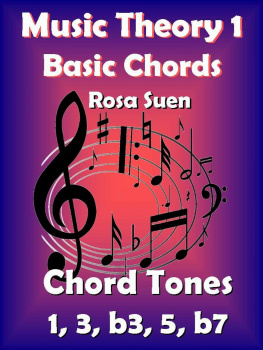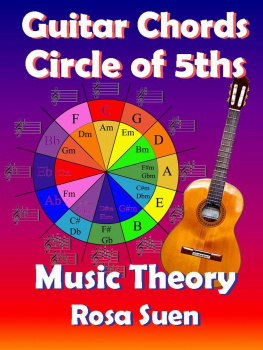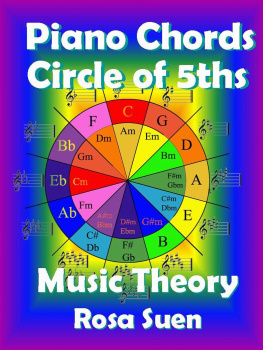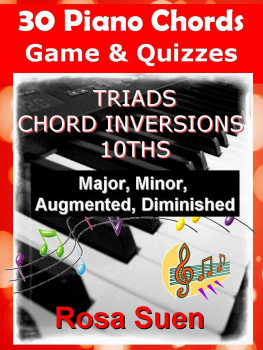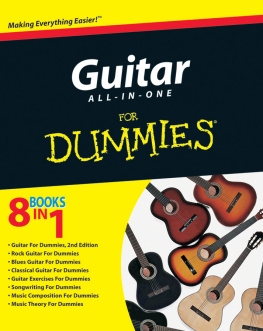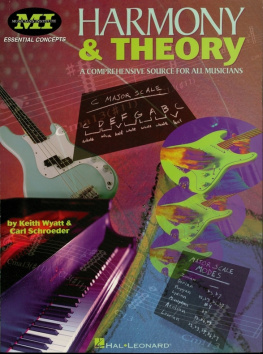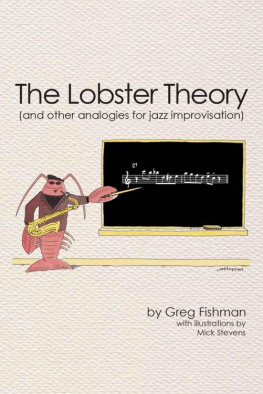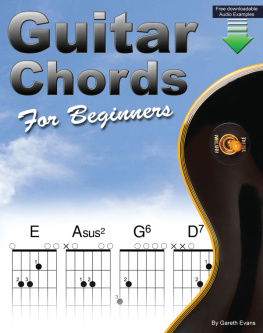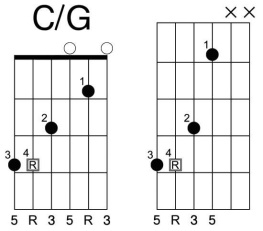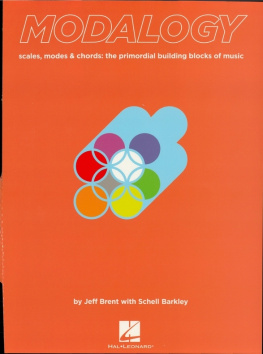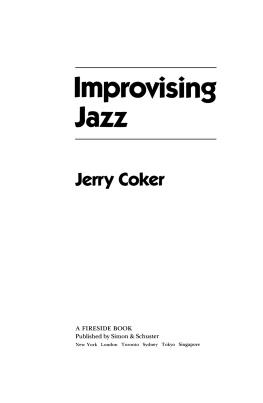The Real Easy Ear Training Book
A Beginning/Intermediate Guide to Hearing the Chord Changes
Roberta Radley
Assistant Chair, Ear Training Department, Berklee College of Music
SHER MUSIC CO.
Petaluma Ca.
www.shermusic.com
NOTES TO USERS OF THIS DIGITAL BOOK
1) Unauthorized duplication, uploading, file-sharing, free downloading,
copying or distribution of any kind of this digital book constitutes theft of
our intellectual property and is expressly prohibited without written
permission from the publisher.
2) The accompanying CD(s) to this digital book can be downloaded for free
at http://shermusic.com/mediafiles/9781883217617.zip. See the left-hand sidebar of our home page.
This book is dedicated in loving memory to my late father, Robert Anthony Radley, one of my all-time biggest fans.
Published by Sher Music Company
P.O. Box 445
Petaluma CA 94953
www.shermusic.com
2008 by Sher Music Co.
All rights reserved. No part of this book or CDs may be reproduced in any manner without prior written authorization from the publisher.
ISBN 1-883217-61-X
Printed in the United States of America.
Editors: Bill Brinkley, Allan Chase, Roberta Radley, Chuck Sher.
All musical examples performed and recorded by Brad Hatfield of Brad Hatfield Productions.
Cover artwork: Roberta Radley, Untitled, 1970. Block print.
Cover design, book design and production, music typesetting:
Wm. R. Brinkley & Associates, Inc. Watertown, MA.
www.wrbrinkleydesign.com
C ONTENTS
L IST OF A CTIVITIES
A CKNOWLEDGEMENTS
Thank you to Mr. Chuck Sher for publishing my debut book The Real Easy Ear Training Book. This has been an incredible opportunity and experience for me, a life-time dream fulfilled. I am honored to have my book included in the very good company of the Sher Music catalogue. Throughout this project, youve always offered 110% encouragement and support.
A heart-felt thank you to my sisters and brother, Maureen, Christina and Richard Radley, who have always been there for me no matter what. But especially to my mother, Mary Catherine Bernadette, my earliest musical mentor, who can still hit all the high notes...a loving thank you.
Thanks to all my students, both in the live as well as virtual classroom. You have taught me a tremendous amount and have been an inspirational audience. Your contributions appear in every line of this book.
Thank you to my colleague, Allan Chase, who devoted many hours to text editing as well as offering expert advise on musical and pedagogical issues. Thank you for your excellent eye.
Thanks to my dear friend, Brad Hatfield, who performed and recorded all of the musical examples you hear on the CDs. Such a talented and creative musician, he made the real music examples come alive with an authenticity true to the intention of the original song recordings. As an ear training book, it was imperative to me that students be engaged as motivated listeners throughout their studies. Thanks, Brad!
Having left the best for last, a huge thank you to my husband, Bill Brinkley, for contributing on so many levels to the making and realization of this book. From book design to putting the final touches to text editing and conceptual clarity, Bill has been there every step of the way with me and for me. An accomplished musician (one very fine guitarist!) he has offered me counsel on many musical aspects of the book. Bills work ethic and drive to make things the best they can be is of the highest level and is one of the things I most admire about him. Behind every woman who writes a book on hearing the changes is a great man. Thank you, sweetheart.
I NTRODUCTION
Welcome to The Real Easy Ear Training Book, where we will take the journey together to hearing the changes. It is a challenging journey, but with a good map to follow, and plenty of gas in the tank, well make it.
In my student days, ear training didnt come easy, particularly when it involved hearing chords and recognizing chord progressions. Though I had been playing piano for several years, all those chords my hands were playing, and my eyes were seeing on the page, werent registering consciously in my ear. It wasnt until I attended Berklee that this dilemma came to the foreground, and I had some catching up to do, and fast! I was in awe of my classmates who already had some experience with identifying chord patterns by ear, and that pushed me to find my own ways of doing the same. Thus, the approaches and techniques I developed as a student for hearing the changes have become the essence of whats in this book.
I also tribute the thousands of ear training students Ive worked with over the past 30 yearsthey helped me understand the multiple challenges and learning styles that each student possesses. As a result, I can anticipate what your challenges and questions will be, and have developed a repertoire of varied approaches in assisting you through the maze of hearing the changes.
This book is designed for a wide and varied audience. You can work through it on your own, with a friend, a teacher, band members, or classmates. If you are a teacher, I hope you find that this book enhances your work with your students, and adds to your own fine methods of teaching ear training.
The chord patterns and musical references are not limited to any particular style of music. All contemporary genres are represented: pop, rock, Latin, fusion and jazz, etc. In addition, the audio files are not piano-centric, and many different instrumentations are used in order to appeal and relate to a rich community of musicians.
There are only good ways to practice hearing the changes, no bad ones. The fact that youre taking these first steps towards recognizing chords and chord progressions is in itself a very good thing. In fact, the only bad thing would be to avoid trying, postponing the practice to a future better time. Taking the first steps now or later will still be first steps. So why delay? Theres no time like the present.
Is it cheating to use your instrument in figuring out the changes? Absolutely not! Our goal is to hear chord progressions on our own, using only our inner hearing. Along the way we may need help: at those times, use your instrument, or a keyboard, for reference. In fact, double-checking on an instrument to confirm your answers is the smart thing to do. After all, for many of you, developing your ability to hear the changes will increase your command as a player.
I do recommend singing as a great way to internalize the sound of the chord progression. Throughout this book, youll be frequently asked to sing, to feed your inner hearing, as well as to confirm out loud what your inner hearing is hearing.
A complete knowledge of music theory is not required to hear the changes, but some theoretical knowledge will be very helpful. This is an ear training book, not a theory book, but at times I will reference harmonic theory as a guide. Many of our brains are filled with harmonic theory; now its time to put that knowledge to work in hearing the harmony.
This book encorporates popular chord patterns, step by step, slowly adding to our harmonic vocabulary list. To avoid being overloaded with too many options, well start with just a few harmonic choices. Well begin by hearing the bass line in the major key, then gradually add major and minor diatonic triads to the mix, discuss the relationship of melody and harmony, continue on with seventh chords recognition, explore hearing minor key harmony, and conclude with hearing some common non-diatonic chord patterns.

